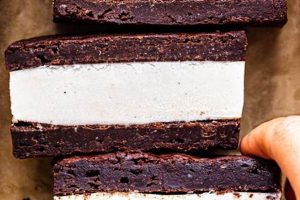A guide to producing frozen desserts devoid of animal products, incorporating pistachio nuts as the primary flavor component, and providing step-by-step instructions for its preparation. Such instructions detail the quantities of ingredients, equipment required, and the sequential processes involved in achieving the desired consistency and flavor profile.
The significance of this lies in its accessibility to individuals adhering to plant-based diets or those with dairy intolerances, while still offering a palatable and enjoyable treat. Furthermore, the utilization of pistachios contributes nutritional value, providing healthy fats, protein, and antioxidants. Historically, frozen desserts have often relied on dairy; the emergence of plant-based alternatives broadens accessibility and addresses evolving dietary preferences.
The subsequent sections will delve into specific ingredient considerations, optimal preparation techniques, and variations that can be implemented to tailor the frozen confection to individual preferences. Furthermore, guidance on storage and serving suggestions will be provided.
Guidance for Achieving Optimal Results
The following recommendations aim to improve the quality and consistency of the final product, ensuring a desirable sensory experience.
Tip 1: Pistachio Selection: Employ high-quality, raw pistachios for the most intense flavor. Avoid salted or roasted varieties as they can negatively impact the taste profile and texture.
Tip 2: Nut Activation: Soaking pistachios in water for several hours, or overnight, can soften them, resulting in a smoother final texture after blending.
Tip 3: Base Selection: Coconut cream offers a rich and creamy base. Alternatively, cashew cream provides a neutral flavor, allowing the pistachio to be the dominant flavor component.
Tip 4: Sweetener Adjustment: Agave nectar, maple syrup, or granulated sugar can be used to achieve the desired sweetness. Adjust the quantity based on individual preference and the natural sweetness of the pistachios.
Tip 5: Stabilizer Usage: Guar gum or tapioca starch can prevent ice crystal formation, resulting in a smoother, more stable frozen dessert. Use sparingly, as excessive amounts can create a gummy texture.
Tip 6: Churning Process: Pre-chill the ice cream maker bowl thoroughly, as specified by the manufacturer’s instructions. Follow the manufacturer’s guidelines for churning time to achieve the desired consistency.
Tip 7: Ripening Period: After churning, transfer the dessert to an airtight container and freeze for at least 2-3 hours to allow it to fully ripen and develop its final texture.
Adhering to these suggestions facilitates the creation of a high-quality, plant-based frozen confection that highlights the unique characteristics of the pistachio nut.
The subsequent sections will explore potential variations and serving suggestions, providing additional avenues for customization and enjoyment.
1. Ingredient Substitution
Ingredient substitution is foundational to the development of frozen desserts devoid of animal products, particularly in achieving a palatable and texturally appropriate final product. The successful creation of this type of confection hinges on careful selection of plant-based alternatives that mimic the properties of traditional dairy-based components.
- Dairy Milk Replacement
Dairy milk, traditionally contributing richness and creaminess, can be substituted with coconut cream, cashew milk, or oat milk. Each alternative imparts a unique flavor and texture. Coconut cream offers a high fat content, mimicking the richness of dairy, while cashew milk presents a more neutral flavor profile. Oat milk provides a slightly sweet taste and a smoother consistency. The choice of substitute significantly alters the final flavor and mouthfeel.
- Egg Yolk Alternatives
Egg yolks, used as emulsifiers and stabilizers, can be replaced with ingredients such as cornstarch, tapioca starch, or lecithin. These substitutes contribute to a smoother texture and prevent ice crystal formation. The quantity required varies depending on the chosen substitute and the desired consistency.
- Fat Sources
Dairy fat can be replicated using plant-based fats such as coconut oil or cocoa butter. These fats contribute to the overall richness and structure of the frozen dessert. The melting point of the chosen fat influences the texture and stability at different temperatures.
- Sweeteners
Refined sugar can be substituted with natural sweeteners such as maple syrup, agave nectar, or date syrup. Each alternative contributes a distinct flavor profile and may affect the overall texture of the final product due to varying sugar concentrations and moisture content. Adjustments to the recipe may be necessary to compensate for these differences.
These substitutions are crucial in adapting traditional recipes for plant-based diets, allowing for the creation of a frozen dessert that closely approximates the sensory qualities of its dairy-containing counterpart. The careful consideration of each substitution’s impact on flavor, texture, and stability is paramount in achieving a desirable result.
2. Pistachio Quality
The quality of pistachios serves as a foundational determinant in the sensory characteristics and overall success of plant-based, pistachio-flavored frozen desserts. High-quality pistachios contribute significantly to the flavor intensity, color, and textural properties of the final product. Therefore, selection criteria are critical in the production process.
- Flavor Intensity
Superior-grade pistachios possess a concentrated and characteristic nutty flavor. Conversely, substandard nuts may exhibit a muted or even rancid taste, negatively impacting the overall palatability. Utilizing high-quality pistachios ensures a prominent and desirable flavor profile, minimizing the need for artificial flavor enhancements.
- Color Characteristics
The vibrant green hue of pistachios contributes visually to the appeal. High-quality pistachios typically exhibit a deeper, more intense green color compared to lower-quality alternatives. This visual characteristic is especially important in plant-based iterations where artificial colorants are often avoided.
- Fat Content and Texture
Pistachios contain a considerable amount of fat, which contributes to the creamy texture of the frozen dessert. Higher-quality pistachios generally have a more favorable fat content, enhancing the overall mouthfeel and reducing the formation of ice crystals. This characteristic is especially crucial in plant-based recipes where the dairy fat component is absent.
- Absence of Defects
High-quality pistachios are typically free from defects such as mold, insect damage, or shell fragments. The presence of these defects can compromise the flavor, texture, and safety of the final product. Careful inspection and sourcing from reputable suppliers are essential to ensure the absence of these undesirable elements.
The aforementioned aspects of pistachio quality directly impact the resultant frozen dessert. Utilizing inferior-quality pistachios can necessitate compensatory measures, such as flavor additives or texturizers, potentially compromising the natural and authentic character. Consequently, prioritizing the selection of superior-grade pistachios is paramount in achieving a high-quality, plant-based, pistachio-flavored frozen dessert.
3. Freezing Technique
The freezing technique is a critical determinant in the final quality of plant-based pistachio frozen desserts. Inadequate freezing can result in an undesirable texture characterized by large ice crystals, compromising the creamy mouthfeel expected of a premium frozen dessert. The process of chilling the mixture, churning to incorporate air and break up ice crystal formation, and subsequent hardening significantly influence the final product. Without appropriate control over freezing, the absence of dairy fat, which naturally inhibits ice crystal growth, becomes a significant challenge.
Specifically, a slow freezing rate encourages the formation of large ice crystals, leading to a grainy or icy texture. In contrast, rapid freezing accompanied by continuous agitation, such as that achieved through an ice cream maker, promotes the formation of smaller ice crystals, resulting in a smoother, creamier texture. Furthermore, the initial temperature of the mixture before freezing affects the outcome. Pre-chilling the mixture helps ensure a more even freezing process and minimizes the likelihood of ice crystal formation. Proper freezer temperature maintenance is also essential after churning to prevent thawing and refreezing, which inevitably leads to larger ice crystals.
In summary, meticulous attention to the freezing technique is paramount in achieving a desirable texture in plant-based pistachio frozen desserts. The interplay between freezing rate, agitation, initial temperature, and freezer maintenance directly influences the formation of ice crystals, which ultimately dictates the overall quality and palatability of the final product. Mastering these elements is crucial to creating a commercially viable and consumer-pleasing plant-based frozen confection. Overlooking this stage often results in a substandard product regardless of the quality of other ingredients and processes.
4. Texture Optimization
Texture optimization is a critical facet in the development of plant-based pistachio frozen desserts, particularly given the absence of dairy-derived fats and proteins that traditionally contribute to a smooth and creamy consistency. Strategies aimed at improving texture are essential to replicate the sensory attributes of conventional ice cream.
- Stabilizer Incorporation
Stabilizers, such as guar gum, locust bean gum, or tapioca starch, play a crucial role in minimizing ice crystal formation during the freezing process. These hydrocolloids bind water, thereby reducing its availability for ice crystal growth. The judicious use of stabilizers is essential; excessive amounts can result in a gummy or unpleasantly viscous texture, while insufficient quantities fail to prevent coarseness. Specific to pistachio frozen desserts, stabilizers also aid in suspending the finely ground pistachio particles, preventing them from settling and creating a uniform texture throughout.
- Fat Content Manipulation
The judicious use of plant-based fats, such as coconut oil or cocoa butter, can contribute to the creamy mouthfeel that is otherwise lacking in dairy-free formulations. These fats solidify during freezing, providing structure and reducing the icy sensation. However, the type and quantity of fat must be carefully considered; some fats impart distinct flavors that may clash with the pistachio profile, while excessive fat can lead to a greasy or heavy texture. The melting point of the fat is also a critical factor, affecting the dessert’s behavior at serving temperature.
- Emulsification Techniques
Emulsification is the process of dispersing fat molecules evenly throughout the water-based mixture, preventing them from coalescing and creating a smoother texture. This can be achieved through the use of emulsifiers like sunflower lecithin or through mechanical means, such as high-speed blending. In pistachio formulations, proper emulsification also contributes to the stability of the ground nut particles, preventing separation and maintaining a homogeneous texture. The effectiveness of emulsification is often influenced by temperature and blending time, requiring precise control during the preparation process.
- Solid-to-Liquid Ratio Adjustment
The ratio of solid to liquid ingredients directly impacts the texture and scoopability of the frozen dessert. A higher proportion of solids, such as pistachio paste or nut butter, contributes to a denser and more stable texture. Conversely, an excess of liquid can lead to a softer, icier product. Balancing these components is critical to achieving the desired firmness and resistance to melting. Additionally, the size of the pistachio particles influences the perceived texture; finely ground nuts create a smoother mouthfeel, while larger pieces provide a more textural contrast.
In conclusion, effective texture optimization in plant-based pistachio frozen desserts requires a multi-faceted approach, incorporating stabilizers, manipulating fat content, employing emulsification techniques, and adjusting the solid-to-liquid ratio. Each of these strategies interacts synergistically to replicate the creamy, smooth, and stable texture characteristics of conventional dairy-based ice cream, ensuring a satisfying sensory experience for the consumer.
5. Flavor Enhancement
Flavor enhancement plays a crucial role in the creation of plant-based pistachio frozen desserts. Given the absence of dairy components, which contribute inherent richness and depth of flavor, strategic augmentation becomes essential to achieving a palatable and commercially viable product. The following facets explore key techniques for enhancing the pistachio flavor profile in these frozen confections.
- Pistachio Paste Concentration
Increasing the concentration of pistachio paste or butter directly amplifies the inherent flavor of the nut. The selection of high-quality, minimally processed pistachio paste is paramount, as it provides a more authentic and intense flavor compared to extracts or artificial flavorings. Furthermore, the roasting of pistachios prior to paste preparation can further intensify their inherent flavors through Maillard reaction products.
- Salt Application
Strategic application of salt, typically in the form of sea salt or Himalayan pink salt, enhances the perceived sweetness and nuttiness of the pistachio. Salt acts as a flavor potentiator, suppressing bitterness and accentuating desirable flavor attributes. The optimal concentration of salt is critical; excessive amounts can result in an unpalatable, salty taste, while insufficient quantities fail to elicit the desired flavor enhancement.
- Complementary Flavor Infusion
The infusion of complementary flavors, such as almond extract, vanilla extract, or cardamom, can enhance the complexity and depth of the pistachio flavor profile. These ingredients work synergistically, complementing the inherent nutty and slightly sweet characteristics of the pistachio. The selection of high-quality extracts is essential to avoid artificial or overpowering flavors.
- Textural Contrasts
The incorporation of textural contrasts, such as chopped pistachios, candied pistachio pieces, or a ripple of pistachio brittle, can enhance the overall sensory experience. The interplay between the smooth, creamy texture of the frozen dessert and the crunchy, brittle texture of the added components provides a more dynamic and engaging flavor profile. These textural elements also contribute to a more visually appealing product.
In summary, the strategic implementation of flavor enhancement techniques is indispensable in the production of plant-based pistachio frozen desserts. By manipulating the concentration of pistachio paste, applying salt judiciously, infusing complementary flavors, and incorporating textural contrasts, a flavor profile can be created that rivals or exceeds that of traditional dairy-based counterparts. Attention to these details elevates the sensory experience and contributes to a more appealing and commercially viable final product.
Frequently Asked Questions About Vegan Pistachio Ice Cream Recipes
The following addresses common inquiries regarding the formulation and execution of recipes for frozen desserts absent of animal-derived products, specifically focusing on pistachio flavor profiles.
Question 1: What constitutes a “vegan” pistachio ice cream recipe?
A “vegan” pistachio ice cream recipe explicitly excludes all ingredients derived from animals. This encompasses dairy milk, cream, butter, eggs, and any other animal-based additives, substituting them with plant-derived alternatives.
Question 2: Which plant-based milk alternatives are suitable for creating a creamy texture?
Several plant-based milks can yield a desirable creamy texture. Coconut cream, cashew milk, and oat milk are frequently employed due to their inherent fat content and emulsifying properties. The selection depends on the desired flavor profile and consistency of the final product.
Question 3: How can ice crystal formation be minimized in the absence of dairy fat?
Ice crystal formation can be mitigated through the incorporation of stabilizers such as guar gum, xanthan gum, or tapioca starch. These hydrocolloids bind water molecules, preventing their aggregation into large ice crystals. Proper churning and rapid freezing techniques are also critical.
Question 4: What role does sugar play in a vegan pistachio ice cream recipe?
Sugar serves multiple functions: it contributes to sweetness, lowers the freezing point of the mixture, and influences the texture. Different sweeteners, such as agave nectar, maple syrup, or cane sugar, impart distinct flavor nuances and require careful consideration of their impact on the overall recipe.
Question 5: How does pistachio quality affect the final product?
The quality of the pistachios directly correlates with the intensity of the flavor and the color of the ice cream. High-quality, raw, unsalted pistachios yield the most vibrant flavor and color. Pistachios exhibiting signs of rancidity or staleness should be avoided.
Question 6: What is the recommended storage method for vegan pistachio ice cream?
Optimal storage involves transferring the churned ice cream to an airtight container and freezing it at a consistent temperature of -18C (0F) or lower. This minimizes temperature fluctuations that can induce ice crystal growth and compromise the texture. Consume within two weeks for optimal quality.
Understanding these key principles contributes significantly to successfully formulating and executing recipes for this dessert.
The following section will offer example recipes, providing a practical application of the concepts discussed herein.
Conclusion
The preceding analysis has systematically examined the critical aspects of producing “vegan pistachio ice cream recipe.” Emphasis has been placed on ingredient selection, particularly the substitution of dairy-based components, as well as the impact of pistachio quality on flavor and visual appeal. Furthermore, the importance of freezing techniques and texture optimization, including the use of stabilizers and fat manipulation, has been thoroughly explored. The strategic application of flavor enhancement methods, such as the use of pistachio paste and complementary flavor infusions, has also been highlighted as essential for achieving a desirable sensory experience.
Ultimately, mastering the complexities inherent in “vegan pistachio ice cream recipe” requires a comprehensive understanding of ingredient interactions, processing techniques, and the interplay between flavor and texture. The pursuit of excellence in this area contributes to the expansion of plant-based culinary options and caters to the evolving dietary preferences of a discerning consumer base. Further research and innovation will undoubtedly lead to advancements in ingredient technology and processing methods, thereby further refining the quality and accessibility of plant-based frozen desserts.







